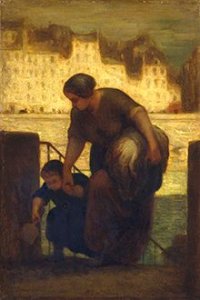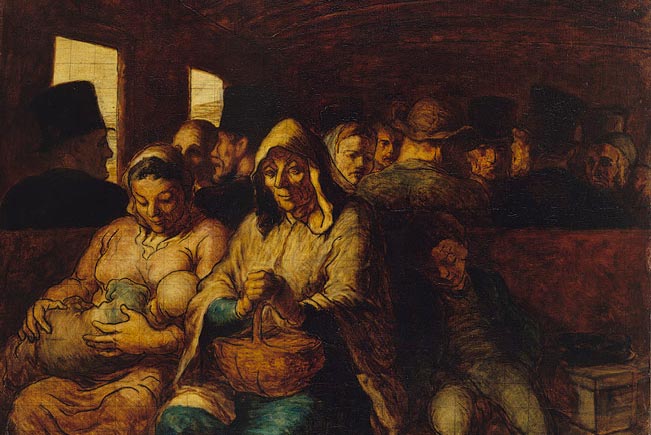Earlier this year, on a morning brisk and bright, I stood on the Quai d’Anjou – a tree-lined embankment of the Île St Louis – looking up at the building where Daumier lived for much of his life. A mansion in pale, yellow stone, it exhales the breezy elegance of Parisian wealth. So it is hard to imagine that when Daumier lived there, in an apartment on the top floor, this building – like so many in the area – was carved up into meager lodgings and inhabited by bohemians and the struggling poor.

The Laundress (1861–3), Honoré Daumier Photograph: © The Metropolitan Museum of Art/Art Resource/Scala, Florence
To stand before the Laundress on the Quai D’Anjou (1861–3) one of the paintings currently on show at the Royal Academy, is to see the Île St Louis as Daumier knew it. The left bank glows in the distance, and the laundress – cast into soft shadow with Daumier’s bold use of contre-jour – ascends the steps from the river, her washing bundled in one arm and a child pulling on the other. You can feel the weight of the laundry, the forward tug of the small child’s eager steps. In the breadth and rapidity of Daumier’s brushwork, individual features are indistinct (whether she is pretty or plain, one cannot tell), but such particulars drift into irrelevance: what Daumier captures, is her fatigue and the simple dignity with which she accomplishes this everyday task.
Walking through this small (yet perfectly formed) exhibition, it is easy to see why Daumier has numerous times been likened to Michelangelo. Like him, Daumier was a sculptor as well as a draughtsman: the delightful clay heads that Daumier made of the figures of his day, their features exaggerated in bold tweaks of clay and the press of thumb, are some of the particular treats on show. Like Michelangelo too, Daumier knew how to express the torsion of bodies, the weight and curve of muscle and bone in athletes and old men alike. And yet, what distinguishes Daumier’s velveteen lithographs and muscular paintings from the work of his Italian predecessor, is the resounding humour and compassion with which he treats the lowliest of his fellow men and the most incidental aspects of their lives.
It is this compassion that brings the Paris of the mid-19th century alive on the walls of the RA’s Sackler Wing. As a staunchly Republican caricaturist and satirist, we might expect his work to be, on occasion, caustic: yet, even when treating the harshest injustices and scrutinising the most unpleasant foibles of the human character, he does so with characteristic wit and sympathy.
For newcomers to Daumier, this exhibition offers a delightful appetiser.
One reviewer has remarked that, for a visitor unfamiliar with his work, this exhibition does not provide enough contextual information. Such comment is undeserved: each image is accompanied by a brief but apt text, providing a valuable insight into an extremely complex socio-political context. Any more information, and the power of the images would be drowned out by the weight of words.
It is also a misguided remark, as it suggests that, without a thorough elucidation of Daumier’s political motivation – which no small exhibition could ever presume to offer – the power of his fine work is lost to us. However, when we see Daumier’s lithograph depicting the events of the April 1834 riot in the Rue Transnonain, and see how he makes the focus the lifeless body of a man in his nightshirt, slumped across a dead child, we do not need details: Daumier’s sense of the cruel injustice, the inhumanity of the episode, strikes the viewer immediately. In his brisk lines, in the firmly contoured chiaroscuro, he offers his own volatile vision of Paris with a voice at once tender, loud and clear.
‘Daumier (1808-1879): Visions of Paris’ is at the Royal Academy of Arts until 26 January 2014.
Unlimited access from just $16 every 3 months
Subscribe to get unlimited and exclusive access to the top art stories, interviews and exhibition reviews.














![Masterpiece [Re]discovery 2022. Photo: Ben Fisher Photography, courtesy of Masterpiece London](http://www.apollo-magazine.com/wp-content/uploads/2022/07/MPL2022_4263.jpg)
It’s time for the government of London to return to its rightful home